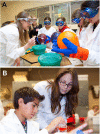A Course-Based Teaching Experience for STEM Undergraduates Improves Student Perceptions of Teaching Self-Efficacy and Attitudes Toward Teaching Careers
- PMID: 34978924
- PMCID: PMC9250364
- DOI: 10.1187/cbe.21-04-0105
A Course-Based Teaching Experience for STEM Undergraduates Improves Student Perceptions of Teaching Self-Efficacy and Attitudes Toward Teaching Careers
Abstract
There is a national need to recruit more science teachers. Enhancing pathways to teaching for science, technology, engineering, and mathematics (STEM) majors could help to address this need. The Learn By Doing Lab is a course in which STEM undergraduates teach hands-on life science and physical science to local third- through eighth-grade schoolchildren visiting the campus. To measure the impacts of this teaching experience on the undergraduate participants, we administered a version of the Science Teaching Efficacy Belief Instrument-Preservice survey at the start and end of the course. Significant gains were observed in the students' belief in their personal ability to effectively teach science (self-efficacy). Furthermore, qualitative and quantitative analysis of student reflections revealed that they perceived the Learn By Doing Lab experience to have helped them develop 21st-century competencies, particularly in the areas of collaboration, communication, and adaptability. Finally, the students' overall awareness and positive perception of science teaching careers increased. This indicates that providing a low-barrier course-based teaching experience for STEM undergraduates is a promising strategy to help recruit pre-service teachers, and a step toward alleviating the national STEM teacher shortage.
Figures







References
-
- Bandura, A. (1977). Self-efficacy: Toward a unifying theory of behavioral change. Psychological Review, 84, 191–215. - PubMed
-
- Bleicher, R. E. (2004). Revisiting the STEBI-B: Measuring self-efficacy in preservice elementary teachers. School Science and Mathematics, 104, 383–391. 10.1111/j.1949-8594.2004.tb18004.x - DOI
-
- Briggs, S. (2013). How peer teaching improves student learning and 10 ways to encourage it. InformEd. Retrieved May 3, 2021, from www.opencolleges.edu.au/informed/features/peer-teaching/
-
- Bruno, P. A., Love Green, J. K., Illerbrun, S. L., Holness, D. A., Illerbrun, S. J., Haus, K. A., ... & Sveinson, K. L. (2016). Students helping students: Evaluating a pilot program of peer teaching for an undergraduate course in human anatomy. Anatomical Sciences Education, 9(2), 132–142. 10.1002/ase.1543 - DOI - PMC - PubMed
MeSH terms
LinkOut - more resources
Full Text Sources
Miscellaneous

